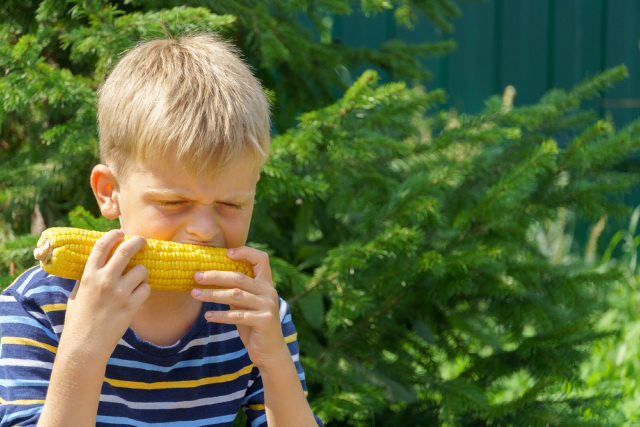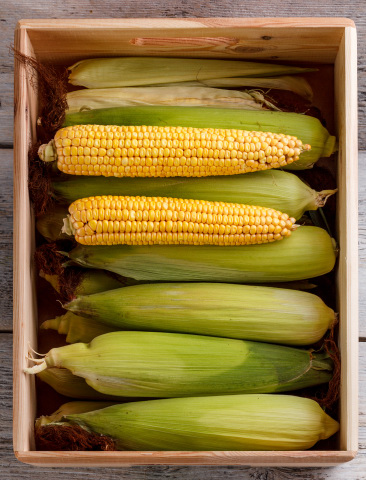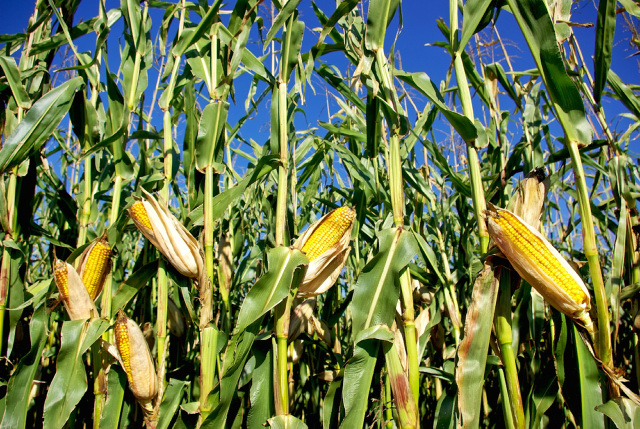Corn is one of the most enjoyed vegetables around. Many agree that nothing tastes better than a fresh ear of sweet corn with some salt and butter. But what if you bite into that ear of corn only to find out that it has a sour taste? Here I’ll talk about why sweet corn can taste or smell sour and what to do with sour corn.

Table of Contents
- Why Is My Corn Sour?—The Short Answer
- How Does the Age of Corn Affect Its Taste?
- How Storing Corn Can Affect Its Taste
- How the Type of Corn Affects Its Taste
- Preservatives Used in Commercially-Grown Corn
- How to Grow and Harvest Corn for the Best Taste
- Is it Dangerous to Eat Sour Corn?
- Can I Tell if Corn Will Taste Sour?
- How Can I Sweeten Corn?
Why Is My Corn Sour?—The Short Answer
Fresh corn should have a sweet and pleasant flavor. If you prepare an ear of corn and find that its flavor is a bit off or sour-tasting, it is most likely because the corn is getting old, was not stored correctly, or how the distributor or grocery store preserved it. However, if the problem is with corn you’ve grown at home, the issue could be how you grew or harvested it.
How Does the Age of Corn Affect Its Taste?
The farmers who grow corn know that the fresher it is, the better it will taste. The reason for this fact has to do with the makeup of the corn. An ear of fresh corn you’ve recently picked will have a lot of sugar and a little starch. However, it doesn’t take very long after harvesting for these natural sugars to quickly convert into starch and affect the taste of the corn.
The longer the corn sits around after it has been harvested, the more the taste quality will deteriorate. If corn sits around too long before it is cooked and used, it will start to spoil, and at this point, the corn will have both a sour smell and a sour taste.
How Storing Corn Can Affect Its Taste
As mentioned, it is best to eat your corn as soon as possible after purchasing or harvesting it to ensure that the sugars don’t have a chance to turn into starch and affect the taste. I like to purchase my fresh corn on the day I plan to make and eat it, as I find that it’s a vegetable you don’t really want to store to eat later in the week.
However, if you find yourself at the farmers market eyeing the fresh ears of corn and know that you won’t be able to eat them until a day or two later, you can take a few steps when storing it to help preserve the freshness and taste. However, keep in mind that whichever way you store the corn, the vegetable has a relatively short shelf life.
Storing Corn at Room Temperature
In general, if you purchase corn you know was freshly harvested, you can keep it with the husks on and at room temperature for up to two days. During this time, the corn should maintain its naturally sweet flavor without any issues. After two days at room temperature storage, your corn will start to lose its sweet taste and could begin to turn sour.

Storing Corn in the Refrigerator
You can also keep your corn with or without the husks in the refrigerator for up to three days. However, it would be best if you took care to tightly wrap the corn in plastic wrap before placing it in the refrigerator to ensure that it maintains its moisture and does not dry out. The taste will also be affected as the corn dries out because it is exposed to air.
How the Type of Corn Affects Its Taste
Not all corn varieties have the same level of sweetness; however, you should not expect any of them to taste sour when fresh. If you take a bite of an ear of corn and it’s not as sweet as you expected, it could be that it’s a different variety than you expected or tasted before. If you’re planning to grow corn in your garden, you may want to choose a type that keeps its sweetness the longest after harvesting.
Regular “Sweet” Corn
This basic type of sweet corn has a moderate level of sweetness and is the kind most popularly grown and found for purchase in the supermarket. Examples include “Butter and Sugar” corn that alternates white and yellow kernels or “Silver Queen” corn that has very pale yellow (almost white) kernels.
Sugar Enhanced (SE) Corn
These types of hybrid corn are popular with home gardeners, and you may find them at small farm stands or farmers’ markets. They tend to stay sweet after harvest a bit longer than the regular sweet corn varieties. Some examples include “Sugar Buns” corn, “Peaches and Cream” corn, or “Kandy Korn.”
Super Sweet Corn
As suggested by the name, this type of corn will be the sweetest-tasting. It also takes the longest for the sugar to turn into starch after harvesting. However, they can be harder to grow than the other types of corn. Some examples include “Butterfruit” corn and “Early X-tra Sweet.”
Preservatives Used in Commercially-Grown Corn
When you purchase corn in the supermarket, even during the peak season, you know that it took several days to get there and is not at its prime freshness. The preservatives some farmers use to slow down the spoiling process could cause corn to have a vinegar-like or sour smell.
Additionally, many commercially grown corn has pesticides applied to it during the growing process to prevent insects, which can also affect the taste of the corn.
To avoid poor-tasting corn because of these commercial preservatives and pesticides or storage methods, you should opt to purchase only organically-grown corn or corn that’s in season from a local farmers’ market.
How to Grow and Harvest Corn for the Best Taste
If you’re growing corn in your garden and finding that it does not taste as sweet as you would like, you should make sure that you grow a variety that is best suited for your area. You may have to try several varieties to find what works best with your specific environment. As mentioned earlier, sugar-enhanced and super sweet corn varieties taste sweeter and give you more time between harvest and consumption before spoiling.
Corn is also prone to cross-pollination. So if you plant different varieties quite close to each other, they can cross-pollenate, resulting in starchy or more sour-tasting corn.
Also, ensure you provide your corn crop with ample water and keep weed growth to a minimum by removing them and mulching the area.
Finally, the time in which you harvest your corn also affects the sweetness. Try to harvest the ears of corn when they are at their peak. You can usually tell by the liquid in the kernels turning from clear to milky texture.

Related: How To Grow Corn: A Beginners Guide To Growing Corn
Is it Dangerous to Eat Sour Corn?
If your corn is sour-tasting due to age or poor storage, you should err on the side of caution and toss it instead of eating it. The corn could be starting to grow mold and could make you sick with food poisoning.
However, if your corn is slightly sour tasting because it is conventionally grown corn or “out-of-season” supermarket corn, it should generally be safe to eat. Try rinsing the corn for several minutes under water to remove the preservatives’ residue and help it taste better.
Can I Tell if Corn Will Taste Sour?
When purchasing corn in the supermarket, you can do a few things to make sure that you choose the freshest corn possible and, therefore, the best tasting.
Smell the Corn
The corn should not have a strong or an off smell when you hold it near your nose. Rather, it should smell slightly sweet and fresh.
Feel the Corn
Don’t buy corn that feels squishy between your fingers, as it indicates that the corn is starting to spoil. Instead, look for firm kernels that don’t squish between your fingers.
Observe the Corn
Look for any signs of mold on the corn, such as dark spots or damaged cobs. You also don’t want corn with a bent tip or damaged stem.
Make sure that the husk and silk are still intact and the leaves of the husk are pale or deep green. The silk should not feel slimy and should have a golden color, but not deep brown.
How Can I Sweeten Corn?
If you’ve purchased corn that is not as sweet as you would like but has not spoiled, you can try to prepare it in a way that will sweeten it. One option I’ve tried is adding a bit of sugar to the water when you boil it. About 3 to 4 teaspoons per gallon of water should help improve the taste of the corn.
You can also try leaving it in the husks and cooking it over high heat (like on a grill or roasting at a high temperature) to bring out some of the sweetness. This method works by concentrating the remaining natural sweetness in the ears of corn and adding some flavor from the husks.
Finally, you can try to use the corn in corn chowder or a casserole, as mixing it with other ingredient flavors will help to enhance the taste. Remove the corn from the cobb (I use this corn peeler) and use it in the recipe with the other ingredients, like cream, cheese, or garlic, and olive oil.
The most important thing to remember is that if you have an ear of delicious and fresh corn, you should not have to take any extra steps to sweeten it.
Related Reading:
